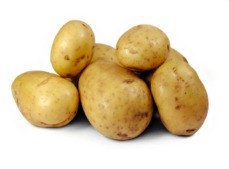Potatoes

Potatoes are members of the Solanaceae family of nightshades along with tomatoes, tobacco and aubergines and are indigenous to Central and South America. Sir Walter Raleigh first brought them to England in 1586 although it was many years before they were universally accepted. Russian peasants would not eat them because they believed they were not Christian, the French thought they were a cause of leprosy and Scottish Presbyterians refused to eat them on the grounds that they were not in the bible! Needless to say, common sense eventually prevailed and they are now a staple food the world over with nearly a third of the world’s potatoes harvested in India and China.
The potato is best known for its carbohydrate value (roughly 25gm per medium sized potato) and for its ‘resistant starch’ content (which once inside the digestive tract will improve nutrient uptake, regulate bowel movement, lower cholesterol, promote good bacteria and suppress bad).
There are literally thousands of potato varieties, bred for their particular culinary properties, for commercial benefit or to adapt to the local climate or soil type.
Potatoes contain toxic chemicals called glycoalkaloids which are also found in other solanaceae family members and are found in the leaves, stem and fruits. The content in the potato tuber itself is increased through damage, light exposure or age and although cooking does partly destroy these compounds, there is still an inherent risk.
Field Science has discovered that through the application of a tailored trace element dressing to the soil prior to ridging, the level of glycoalkaloids is significantly reduced. Also the yield of the crop is improved along with the plant’s ability to resist disease. Although it is yet to be proven that the dressings can reduce the risk of blight, anecdotal evidence tells of much cleaner crops with more saleable potatoes per harvest.
The net effect of applying the Field Science tailored dressing is not only a yield increase but also an increase in the usable share of the crop
The Dressing Process
Field Science tailored mineral dressings are always based on detailed soil analysis of the field to be treated. A member of our technical team will visit your farm to discuss and identify where we can help. Soil samples are then taken and the tailored dressings are based on the independent laboratory’s results.
1 Year Dressing is the only option for potato crops as the soil is worked to such a degree that the previous year’s dressing, if a multiple year dressing was used, would be lost to the plants.
The best time for application is prior to ridge forming or, if possible, after planting although this requires specialist application equipment.
The application rate is usually 25kg per hectare (10kg/ac). The dressings are packed in 25kg bags, clearly labelled with the farm details, field name, application rate and bag weight.
